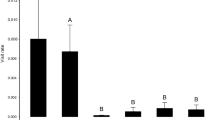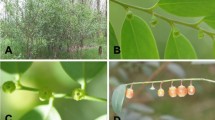Abstract
The pollination biology of a population of 250 Yucca elata (Liliaceae) plants was studied in southern New Mexico. Yucca elata and the prodoxid yucca moth Tegeticula yuccasella have a mutualistic association that is essential for the successful sexual reproduction of both species. However, a wide range of other invertebrate species visit flowers during the day and at night. Our aim was to quantify the role of yucca moths and other invertebrate visitors in pollination and fruit set, using manipulative field experiments. Inflorescences were bagged during the day or night (N=12 inflorescences) to restrict flower visitors to either nocturnal or diurnal groups. Yucca moths were active exclusively nocturnally during the flowering period and thus did not visit inflorescences that were unbagged during the day. None of the 4022 flowers exposed only to diurnal visitors set fruit, whereas 4.6% of the 4974 flowers exposed only to nocturnal visitors (including yucca moths) produced mature fruit. The proportion of flowers producing fruit in the latter treatment was not significantly different from unbagged control inflorescences. In a series of experimental manipulations we also determined that: (1) flowers opened at dusk and were open for two days on average, but were only receptive to pollen on the first night of opening; (2) pollen must be pushed down the stigmatic tube to affect pollination; and (3) most plants require out-cross pollination to produce fruit. The combination of these results strongly suggests that yucca moths are the only species affecting pollination in Y. elata, and that if another species was to affect pollination, it would be a rare event.
Similar content being viewed by others
References
Addicott JF (1986) Variation in the costs and benefits of mutualism: the interaction between yuccas and yucca moths. Oecologia 70: 486–494
Aker CL (1982) Regulation of flower, fruit and seed production by a monocarpic perennial, Yucca whipplei. J Ecol 70: 357–372
Aker CL, Udovic D (1981) Oviposition and pollination behavior of the yucca moth, Tegeticula maculata (Lepidoptera: Prodoxidae), and its relation to the reproductive biology of Yucca whipplei (Agavaceae). Oecologia 49: 96–101
Baker HG (1986) Yuccas and yucca moths—a historical commentary. Ann Missouri Bot Gard 73: 556–564
Barstow JW (1872a) Yucca. Bull Torrey Bot Club 3: 37
Barstow JW (1872b) Yucca filamentosa. Bull Torrey Bot Club 3: 52
Campbell RS, Keller JG (1932) Growth and reproduction of Yucca elata. Ecology 13: 364–374
Coquillett DW (1893) On the pollination of Yucca whipplei in California. Insect Life 5: 311–314
Engelmann G (1872) The flower of yucca and its fertilization. Bull Torrey Bot Club 3: 33
Force DC, Thompson ML (1984) Parasitoids of the immature stages of several southwestern yucca moths. Southwest Nat 29: 45–56
Galil J (1973) Topocentric and ethnodynamic pollination. In: Brantges NBM, Linskens HF (eds) Pollination and dispersal. Botany Dept University Nijmegen. Holland, pp 85–100
Keeley JE, Keeley SC, Swift CC, Lee J (1984) Seed predation due to yucca-moth symbiosis. Am Midl Nat 112: 187–191
Kingsolver RW (1984) Population biology of a mutualistic association: Yucca glauca and Tegeticula yuccasella. PhD Thesis University of Kansas, Lawrence, Kansas USA
Laslei RJG, Ludwig JA (1985) Fruit production by Yucca elata Engelm. (Liliaceae) in four Chihuahuan desert habitats. Southwest Nat 30: 321–322
McKelvey SD (1947) Yuccas of the southwestern United States, Part 2. Arnold Arboretum, Harvard University, Massachusetts, USA
Miles NJ (1983) Variation and host specificity in the yucca moth, Tegeticula yuccasella (Incurvariidae): a morphometric approach. J Lepidopt Soc 37: 207–216
Milligan JM (1874) Yucca filamentosa. Am Nat 8: 749–752
Powell JA (1984) Biological interrelationships of moths and Yucca schottii. Univ California Publ Entomol 100: 1–93
Powell JA, Mackie RA (1966) Biological interrelationships of moths and Yucca whipplei. Univ California Publ Entomol 42: 1–59
Rau P (1945) The yucca plant, Yucca filamentosa, and the yucca moth, Tegeticula (Pronuba) yuccasella Riley: an ecological study. Ann Missouri Bot Gard 32: 373–394
Riley CV (1872) Insects shaped by the needs of flowers. Nature 6: 444
Riley CV (1873a) On the oviposition of the yucca moth. Am Nat 7: 619–623
Riley CV (1873b) On a new genus in the Lepidopterous family Tineidae, with remarks on the fertilization of Yucca. Trans St Louis Acad Sci 3: 55–59
Riley CV (1892) The yucca moth and Yucca pollination. Ann Rep Missouri Bot Gard 3: 99–158
Riley CV (1893) Further notes on yucca insects and Yucca pollination. Proc Biol Soc Wash 8: 41–54
Smith SD, Ludwig JA (1976) Reproductive and vegetative growth patterns in Yucca elata Engelm. (Liliaceae). Southwest Nat 21: 177–184
Smith SD, Ludwig JA (1978) Further studies on growth patterns in Yucca elata Engelm. (Liliaceae). Southwest Nat 23: 145–150
Trelease W (1893) Further studies of yuccas and their pollination. Ann Rep Missouri Bot Gard 4: 181–226
Udovic D (1981) Determinants of fruit set in Yucca whipplei: reproductive expenditure vs. pollinator availability. Oecologia 48: 389–399
Webber HJ (1892) Yucca pollination. Am Nat 26: 774–778
Webber JM (1953) Yuccas of the southwest. U. S. Department of Agriculture, Agric. Monogr. 17: 1–93
Wiggins IL (1980) Flora of Baja California. Stanford University Press, Stanford, USA
Wimber DR (1958) Pollination of Yucca whipplei Torr. Masters Thesis, Claremont Graduate School, Claremont, California
Author information
Authors and Affiliations
Rights and permissions
About this article
Cite this article
James, C.D., Hoffman, M.T., Lightfoot, D.C. et al. Pollination ecology of Yucca elata . Oecologia 93, 512–517 (1993). https://doi.org/10.1007/BF00328959
Received:
Accepted:
Issue Date:
DOI: https://doi.org/10.1007/BF00328959




